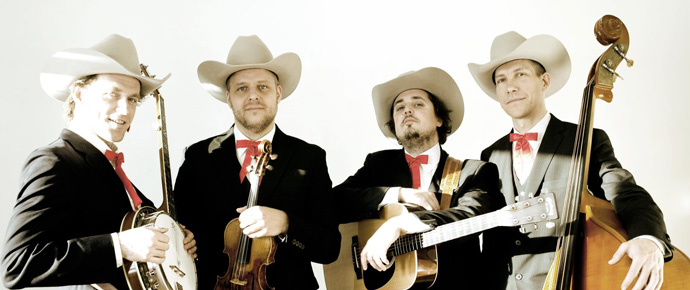
Sweden may be one of the last places on the planet where one might expect to find an active bluegrass band, complete with the suits, savvy, and style that easily ensures authenticity. So credit the Blue Mountain Boys for staying true to tradition and creating a sound so real, it makes them all but indistinguishable from any band originating out of Appalachia or any parts of America’s fertile heartland.
The band originally convened 15 years ago, and while the musicians involved learned the music together from scratch, they were already well versed in a variety of genres, courtesy of a college education.
“The big challenge for us has been to not make this music sound polished,” guitarist Fredrik Mårtensson suggests. “Bluegrass actually proved to be a welcome refuge.”
Mårtensson and banjo player Peter Danielsson first started playing music together when they were classical guitarists, and billing themselves as a duo. “While we were practicing, we would listen to the Johnson Mountain Boys,” he recalls. “One day I said, ‘We should start playing bluegrass together,’ and so the next week, Peter bought himself a banjo. His wife bought earplugs….”
Soon after, they brought another friend into their fold, fiddler Peter Roos, a performer who had been a member of various Irish and Swedish folk music outfits. Bassist Pedro Blom, a veteran of the popular Swedish folk rock outfit Hoven Droven, joined soon after.
With their line-up intact, the Blue Mountain Boys went on to gather other seminal influences as well — Bill Monroe, the Stanley Brothers, Flatt & Scruggs, Jimmy Martin, Reno & Smiley, Jimmy Martin, Jim & Jesse, and The Osborne Brothers among them. Eventually they found themselves drawn to the likes of Del McCoury, Joe Val, Vern Williams, Delia Bell & Bill Grant, Hazel & Alice, Earl Taylor, Larry Sparks, and the Gillis Brothers.
“As time went by, we also discovered Danny Paisley and the Southern Grass, and they had a big impact on us too,” Mårtensson recalls. “We played a festival in Holland which they headlined. Hearing them live was like a punch in the face, but in a good way… a great lesson in what to emphasize in the music. They’re our favorites of the current bands, and Danny Paisley’s singing is unique and unmatched.”
Mårtensson maintains that diversity is key to their creativity. “We love it all really, especially the old stuff,” he insists. “On tour we listen to early country, western swing, brother duos, and old time music. All this being said, our common musical connection would probably be AC/DC. We like powerful music with an edge to it.”
As the only bluegrass band in their immediate area, Mårtensson says they’ve had to convert listeners one audience at a time.
“Generally, people really like the vibe of bluegrass music here, and I think we do a good job playing it live,” he says. “We make people happy. Also, I think we appeal to the crowd who loves traditional bluegrass, and since we sing at least half of our material in Swedish, we might have a broader general appeal than most Swedish bluegrass bands. Off course we’ve also ticked some people off by singing in Swedish. We kind of thrive on that too.”
Mårtensson isn’t surprised by the fact that bluegrass goes over so well at home, even though it’s a wide divide from between the States and Sweden. “It’s true music about real life,” he muses. “It’s intense, powerful and musically diverse, containing subjects with both high and low emotions. There’s something for everyone in it. There’s lots of different kinds of bluegrass too, from traditional and grainy, to contemporary and slick.”
Mårtensson says the goal now is to play in the U.S. “That would give us an opportunity to learn from the original musical maters,” he muses.
Given their diligence and devotion, those ought to be easy lessons to learn.







